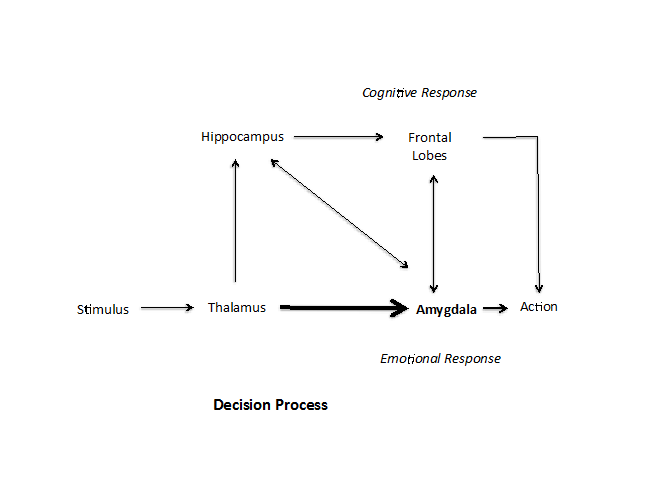At the Time – There is No Choice
We have been discussing the process a child, anyone goes through for a given behaviour event. Of course the caveat still remains that the visual representation below is extremely simplistic but it provides a scaffold on which to begin a more complete explanation.

If we consider this schematic model, it is evident that the only section considered to be under the immediate control of the student is the decision to act and then the actions. This can be referred to as the ‘cognition driven behaviour’ and this is where the various varieties of cognitive behaviour programs operate however it also contains the emotional component of the decision. More about this matter later.
The antecedent condition, for the child will be their current homeostatic status, are they happy, stressed, indifferent, whatever their state it is brought to the situation. For those kids with a history of abuse and neglect and a history of failure rarely do they bring to a situation a sense of homeostatic calm. At this stage of the cycle they have very little control of their ‘condition’ but that will influence their reaction to the situation they find themselves in.
The situation is not in their control especially at school. Even on the broadest sense they have to by law attend school even if it is a source of continuous failure. But like all of us we are always finding ourselves in situations outside our control. That’s life!
At the end of the cycle is the consequence that follows the actions. There is no guarantee that if we act in a certain way we will get a predictable result. This unpredictability will be discussed in a later Newsletter but for now we understand that consequences follow our actions but they are delivered by powers, for these kids at school it is teachers.
This leaves us with the part of the behaviour cycle we could control. The following line of reasoning highlights the failings of cognitive behaviour therapy at times of emotionally charged situations.
The cause of the limitations of cognitive interventions involves our instinctive survival response to threats. In the diagram below the process of responding to a stimulus is represented. How that response is developed depends on how the stimulus incites our memories.

The stimulus linked to the situation comes in to the thalamus, the clearing-house for the brain where it is distributed across the brain. To facilitate our survival when under immediate serious threat that stimulus will go directly to the amygdala. Here we can respond to threat long before we are consciously aware of the situation. This is the general adaptive syndrome or flight/fight immediate adaption to protect us. This process by passes all but genetic memory and is, excluding extensive training, beyond our control. This is the fast track in our decision-making.
But this fast track to the amygdala is also the route to our emotional memories that are located in this area. This means that the emotional memories are the first referenced in regards to the situation. That means we ‘feel’ about the situation before we think about it.
A slower response is through the thalamus to the hippocampus where our cognitive, autobiographical memories are located and then move up to the frontal lobes where a considered decision can be made. It is through this slow track route the cognitive approach operates. We see the situation, we ask what is going on and what can we do to that will make the situation better for us.
This works unless the emotional memory is so powerful that the decision via the so-called slow route is over ridden and the decision will be the habitual one that has been in use. This is a problem for kids who have been raised in abusive, neglectful environments. The way they have learned to respond worked best for them growing-up but is inappropriate in the current situation.
The secret to working with these kids is to create an environment that, as much as possible minimizes those kids being placed in situations that stimulate their destructive emotional memories.